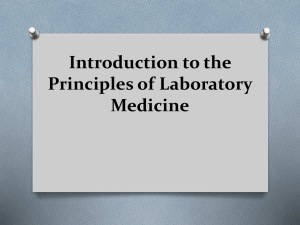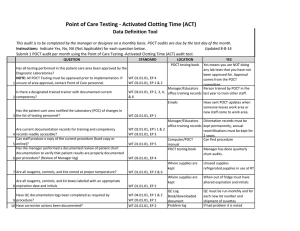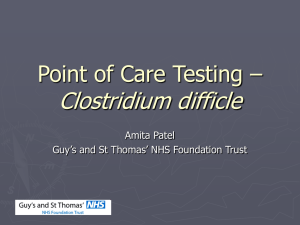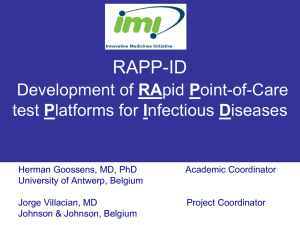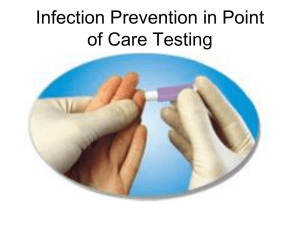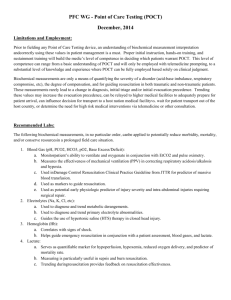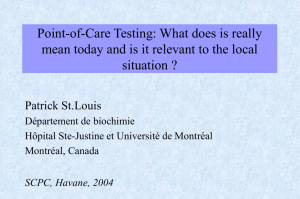Lecture 6
advertisement
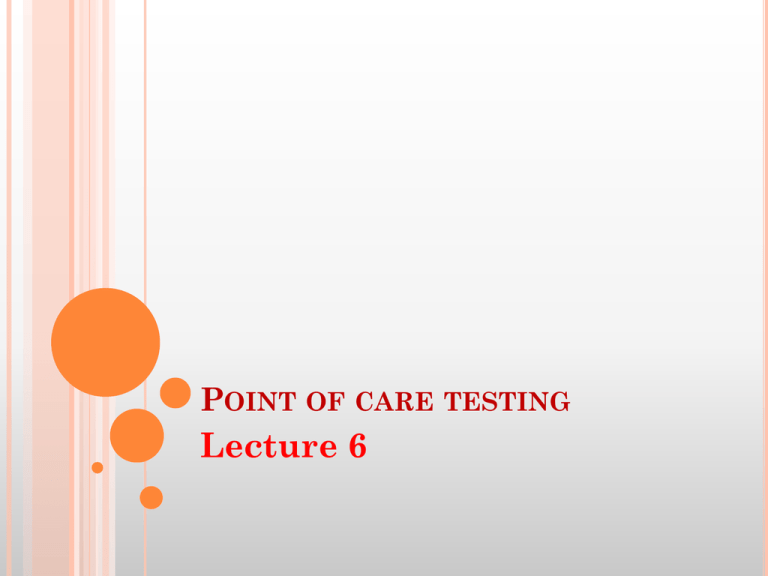
POINT OF CARE TESTING Lecture 6 DEFINITION Medical testing at or near the site of patient care. It is a mode of analysis which is performed at the site where the health care is provided close to the patient. Bed side, near patient, physician’s office, extra laboratory, off site, unit used testing. ADVANTAGES Reduced turnaround time (TAT). Improved health outcomes. Rapid data availability. Self contained and user friendly instruments. Small sample volume for large test menu. Ability to test many types of samples. DISADVANTAGES Bedside tests performed by poorly trained nonlaboratorian. Cost of POCT compared with traditional laboratory testing. Quality of testing is operator dependent. Narrower measuring range for some of the analytes. CHARACTERISTICS OF POCT DEVICES First result in minutes or less. Portable instruments with consumable reagent cartridges. A one or two step operating protocol. The capability of performing direct specimen analysis on whole blood and urine. Simple procedure that do not require laboratory trained operator. CHARACTERISTICS OF POCT DEVICES Built in/ integrated calibration and quality control. Results provided as hard copy, stored and available for transmission. Low instrument cost. Built in regulatory record keeping. Temperature storage for reagents. POINT OF CARE TESTING MIGHT BE EMPLOYED Primary care Home Community pharmacist Health centers (general practice) Workplace clinic Physician’s office Paramedical support vehicle (ambulance, helicopter, air craft ) SECONDARY AND TERTIARY CARE Emergency room Admission unit Operating room Intensive care unit Wards Outpatient clinics TYPES OF DEVICES USED FOR POCT Single use qualitative or semi-quantitative cartridge strip test Single use quantitative cartridge/ strip test with a reader device Multiple use quantitative cartridge/bench top devices SINGLE USE QUALITATIVE OR SEMIQUANTITATIVE CARTRIDGE STRIP TEST Urine chemistry Blood chemistry Infectious disease agents Cardiac markers hCG SINGLE USE QUANTITATIVE CARTRIDGE/ STRIP TEST WITH A READER DEVICE Glucose Blood chemistry Coagulation Cardiac markers Drugs CRP Allergy Fertility testing pH HbA1c Blood gases Electrolytes MULTIPLE USE QUANTITATIVE CARTRIDGE/BENCH TOP DEVICES pH Blood gases Electrolytes Metabolites Complete blood count Bilirubin Cardiac marker CRP POCT DEVICES AVAILABLE IN THE HOSPITALS Blood gases, electrolytes, lactate Cardiac biomarkers, renal markers, Bilirubin Cholesterol, triglyceride and HDL Intra-operative PTH measurement Blood glucose (includes self-testing devices) Alcohol and toxicology (paracetamol, drugs of abuse) Urinalysis(with or without a reader) POCT DEVICES AVAILABLE IN THE HOSPITALS Haemoglobin A1c Albumin Anticoagulant therapy monitoring (includes selftesting devices) Detection of pregnancy and ovulation (includes self-testing devices) Infections(Chlamydia, HIV) Stool occult blood POCT DEVICES AVAILABLE IN COMMUNITY SETTING Blood glucose (includes self-testing devices) Urinalysis(with or without a reader) Cholesterol, triglyceride and HDL Anticoagulant therapy monitoring (includes selftesting devices) Detection of pregnancy and ovulation (includes self-testing devices) CARDIAC MARKERS The American Heart Association has recommended a turnaround time for cardiac markers of 60 minutes. Tests of POCT should be compatible to the results of the central laboratory. Improved diagnosis Shortened emergency department length of stay Decreasing patient time in the emergency department by 45 minutes. GLUCOSE MONITORING PROGRAMME First glucometer was introduced by “Bayer” in 1969. Old standard is the laboratory based test. Glucometer give the rapid and relatively precise glucose estimation on whole blood at the patients bedside. Frequent blood glucose monitoring allows better glycemic control in hospital as well as at home. Reduced morbidity and mortality associated with glycemic control. LIMITATIONS POCT glucose is slightly higher than venous blood. This difference is significant in case of postprandial specimen. Other interferences include hematocrit, po2, temperature and humidity. Use of POCT not recommended in shock, dibetic coma and dehydartion.
